Open air houses for German finisher pigs
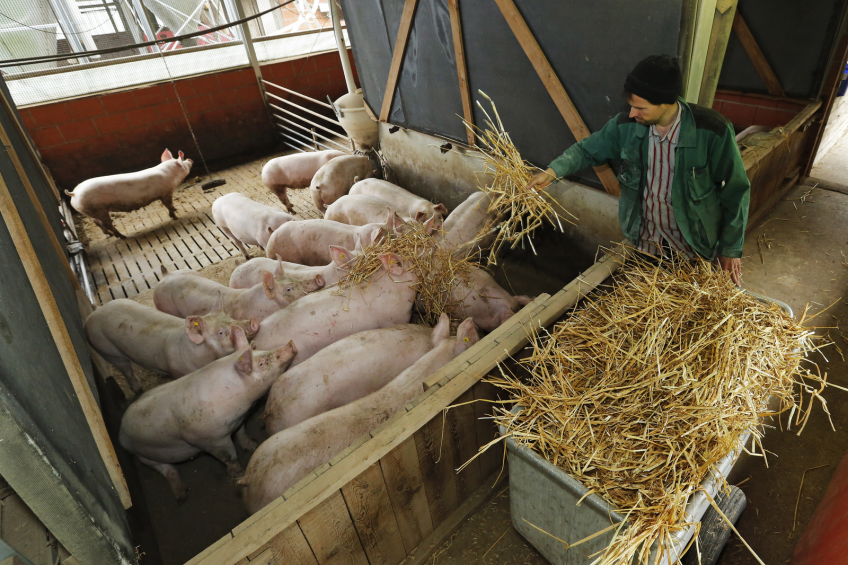
Idealism for more welfare and a better environment made the German family Ahrens-Westerlage invest in open air pig houses for their finisher pigs. Since last year, this resulted in a bonus of roughly €9 per animal.

The Ahrens-Westerlage farm in Neuenkirchen, Lower Saxony, Germany, is a mixed farm with 1,500 finisher pigs. About 1,000 finishers are kept in PigPorts, 500 are kept in conventional pig houses. The farm comes with 90 ha of grounds, of which 65 ha is owned. The arable part is used for growing grains (70 ha) and corn. The pigs are trucked in from the Netherlands; they are crossbreeds (DanAvl x Piétrain). The feed is mixed on-farm; raw materials are stored here as well.
Admittedly, with the North Sea within travelable distance, the winters are relatively mild and scorchers are rare in summer in this part of Germany. Still, temperatures of -10°C in winter or 30°C are not entirely uncommon, which makes it a challenge to keep pigs in open air houses. Nevertheless, that is exactly what Carl, 64, and his son Karl, 35, do at Ahrens-Westerlage finishing farm. The majority of their finishers are kept in so-called ‘PigPorts’, pig houses equipped with natural ventilation, a concept developed by German pig expert Rudolf Wiedmann. One of the houses on the farm, a PigPort 2, was constructed in 2001; the other, from the series PigPort 3, was added to the facility 6 years ago.
PigPort houses increase comfort and decrease ammonia
Carl (senior) Ahrens-Westerlage opted for the PigPort houses for reasons of idealism. He wanted to be able to offer more comfort to his pigs as well as emit less ammonia than the conventional pig houses.
Additional welfare, as well as comfort are reflected in the size of the pens, with divided functional areas for the pigs (lying, eating and dunging) and in the amount of space per pig: 1.2 m2. The environmental advantage is mostly related to the closed floor. In the older pig house, the floor is closed for roughly half, in the newer pig house, the percentage of closed floor is somewhat smaller. According to tests, ammonia emission is 60% lower than in a conventional pig house with a totally slatted floor. In legislation, the ammonia reduction in PigPorts is defined as being 30%.
The pig covers can be closed in case of cold weather. Photo: Henk Riswick.
Inside the PigPorts
In the PigPort 2 building, the animals are kept at 1.2 m2 per animal – this is far above the average of 0.75 m2 which is the minimum requirement by German law. The pens have a depth of 7 m.
The finishing area comes with thick layers of straw, as the 15-year old pig house does not have any heating. In case temperatures fall to low levels, a cover can be closed on top of the pigs, which causes the pigs’ body heat to stay around for longer. The area underneath the cover is then enclosed by 3 walls. The fourth comes with rubber walk-through flaps, so pigs can easily access the dunging and feeding spaces.
Typically, about one month after the transfer into the finishing barn, the straw is gone. As from that moment, they will receive roughage for distraction purposes. In the winter, this is usually silage or straw; in summer this is straw or hay. When the weather is humid, the pigs receive old newspapers. That way, the pens stay dry.
The PigPort 3 pig house at Ahrens-Westerlage is about 6 years old. It is an updated version of PigPort 2 with the main difference being the addition of a heated, curved floor.
Costs and revenues
In total, three pig producers keep their pigs in open air pig houses in Northern Germany, Ahrens-Westerlage being one of them. Building costs are about €400 per place, assuming that each animal takes 1.2 m2. This amount is based on a lot of own labour. In the event of the farm being further automised or calculated without its own labour, building costs would easily exceed €500 per place.
Idealism, so far, hasn’t really paid off in a bonus price for the pigs. Since last year, however, the German animal welfare ‘Initiative Tierwohl’ has been put in place. This allows father and son to earn a premium of about €9 per pig sold to the slaughterhouse.

Still – the 2 farmers are always keen to obtain even more premiums. In June this year, father and son received a visit from meat processor Heristo. Promoting a philosophy around words like ‘fair, reliable, innovative’, this company was interested in processing pigs that were raised in demonstrably higher welfare conditions. In addition, the farm will start keeping pigs with entire tails by the end of the year. This will yield €16.50 per pig delivered to the slaughterhouse.
It’s hard for father and son to estimate how many additional costs exactly are involved in keeping the PigPort system running. The amount of pigs per pen is lower than in conventional pig barns and the system obviously requires more labour. During warm weather, the risk of dirty pens grows with higher temperatures, pigs tend to defecate outside their designated dunging zones. Also supplying roughage usually takes time. Nevertheless, at the farm ample labour time is available.
Different skill set needed than for conventional pig houses
Keeping pigs in PigPorts with open air comes with different skills than in conventional pig houses. The pig producers explain the importance of doing correct animal checkups and reacting swiftly when things change. The older PigPort is open on the east side and is sensitive to wind. In case of much cold wind, it’s paramount to lower the blinds. As already said, at temperatures above 25°C, the risk of dunging everywhere occurs in the older of the two PigPorts.
In normal circumstances, however, the pigs originating from a DanAvl sow and a Piétrain terminal sire, make a healthy impression. The animals barely cough and the pens are full of vital, uniform pigs. Growing results are positive; growth of finisher pigs (both barrows and gilts) are about 900 g/day, and transfer to the finisher is at 30 kg. In the finisher barn, mortality is below 1%. In addition, the farm scores 1.5 on the therapy-index, indicating the usage of antibiotics in Germany. That is relatively low.
Feed conversion is 2.7 and feed costs per kg are €0.57. The vast majority of the feed is grown by the father and son team. They feed a diet consisting of, on average, 60% grains: 25% barley, 10% wheat, 10% triticale and 15% rye. In addition, the feed consists of corn cob mix (CCM), a core and a source of protein. For starter feed, the protein is soy. In the finisher feed, this is replaced by rapeseed. The farm has the capacity to store 600 tonnes of feed.
In the 2nd half of 2016, the farm started to finish pigs with entire tails. In the state of Lower Saxony, €16.50 per pig is being paid for pigs that arrive at the slaughter plant with an entire tail. Participation will last for at least one year. Half of the tail premium is sent to the multiplication farm, as this farm is also investing in not tail docking.


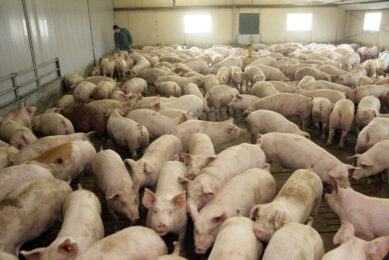
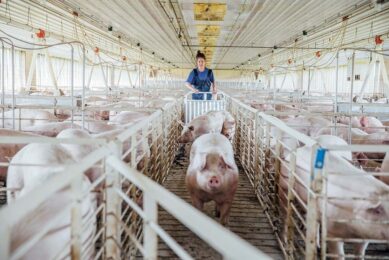
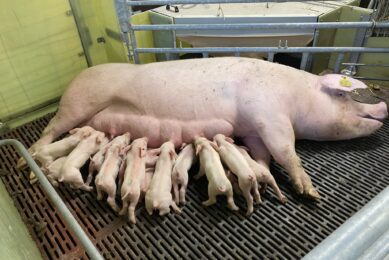
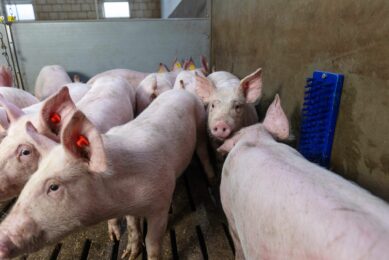





 Beheer
Beheer WP Admin
WP Admin  Bewerk bericht
Bewerk bericht